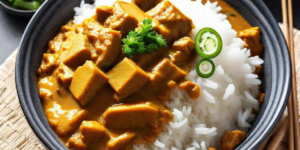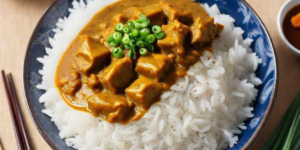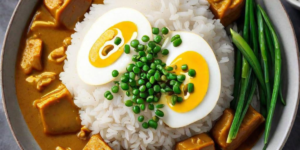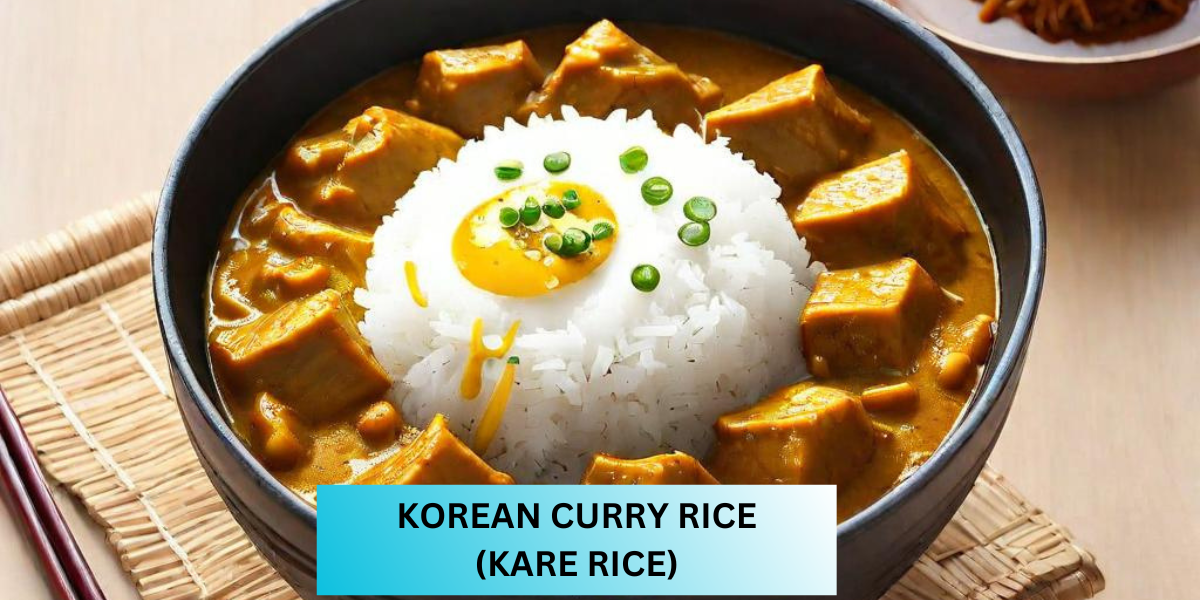INTRODUCTION
It is a stew-like curry sauce that is served over rice and is known as Korean curry rice (ka-re-raice, 카레라이스). This curry sauce is made with instant curry mix. One of those foods that was brought to Korea by the Japanese and has since become a staple in Korean households, it is made up of a variety of ingredients. Generally speaking, the Korean version of the sauce is lighter, which is one of the reasons why it pairs so well with kimchi. Isn’t it a hearty, comfort food that we all ate while we were growing up?
Using the instant curry mix makes it really simple to prepare this dish. In Korea, the powder form is the one that is used the most frequently; however, curry blocks, also known as curry roux, have also gained popularity in recent years. Due to the fact that the curry roux is produced using fat, it has a more robust flavor and causes the sauce to be more viscous. I used a curry roux in this recipe; however, if you are concerned about the amount of fat that the roux contains, you can use curry powder mix instead.
Indian curry rice is typically prepared with a large quantity of veggies and a variety of meats. In this recipe, I used beef on purpose. Naturally, you are free to use any kind of meat that you see fit. Carrots, potatoes, and onions are the traditional ingredients found in this recipe. Adding mushrooms and a green vegetable, such as green bell pepper, peas, zucchini, broccoli, or scallions, is another thing that I enjoy doing occasionally.
The next time you go to a Korean store (or any other Asian market), make sure to pick up a box of curry mix (or a pouch if it’s powder). At a moment’s notice, when you want to whip up a supper that is so wonderful that it only requires one pot, it comes in useful!
Exploring Korean Curry Rice:
A combination of Korean and Japanese culinary influences can be seen in the dish known as Korean Curry Rice, or Kare Rice as it is more commonly referred to. Typically, it is served on top of a bed of steaming rice and is characterized by a thick, savory curry sauce that is lightly spicy and rich in flavor. Korean Curry Rice, in contrast to typical Japanese curry, frequently makes use of regional ingredients and seasonings, which lend it a distinctive personality.

WHAT IS KOREAN CURRY RICE
The fact that Korean curry rice is a dish that is easy to prepare, adaptable to a variety of situations, and satiating makes it a staple in many Korean households, particularly those who have children. While I was growing up in Korea, I would consume it on a weekly basis, either at home or at the cafeteria of my school. The Korean pronunciation of this word is “Kare Raisu / Raiseu (Ṵ레 라이스),” which is reminiscent of the sound of the phrase “Japanese curry rice.” This meal was, in fact, brought to the world by the Japanese.
A taste that is slightly sweet, softly spicy, and savory is characteristic of Korean curry, which has a flavor profile that is distinctive. It is separate from Indian or Thai curry, yet it is comparable to Japanese curry but not the same. This dish is able to easily adapt your preferences, whether you prefer a curry that is heavy on vegetables or one that is predominantly meat-based.
HOW I MAKE MY CURRY
Your choice of a tiny diced cut of meat, whether it be pork, beef, or chicken, is the first step in the preparation of Korean curry rice. The meat is then cooked over the fire until it is gently browned. After that, blend them with a wide range of fresh veggies such as carrots, potatoes, and onions. After being cooked in water until it reaches the desired tenderness, this hearty mixture is then blended with a Korean curry sauce that is both rich and aromatic, resulting in a dish that is not only savory but also comfortable and gratifying.
I would like to bring to your attention that although pig is the most common ingredient in Korean curry, beef and chicken are also included in the dish.
In point of fact, when I make curry rice, I prefer to use diced beef that is suitable for stewing. When compared to pig, beef has a smell that is less gamey, and stew-friendly cuts are great for simmering because they let the meat to release all of its rich, savory flavor into the curry sauce. I find that beef has a more gamey smell than swine. When you are using lean meat, it is essential to avoid overcooking it because it has the potential to turn dry.
I also prefer to add some butter to the curry in order to discreetly improve the flavors and lessen the amount of spice for my family, despite the fact that the curry itself is not extremely spicy. In addition to imparting a delightfully buttery flavor, this ingredient also provides a distinctive spin on the dish. It should be brought to your attention that this is not a regular habit among Koreans, who typically prefer their curry in its natural state.
When everything has reached the desired level of doneness, the curry is then poured over a bed of fluffy rice that has been steamed. The sweet overtones of the onions and carrots, the savory depth of the meat, and the perfectly balanced combination of these flavors are all perfectly balanced by the subtly spicy, umami-rich curry. Each bite is a delicious blend of sensations.

INSTANT KOREAN CURRY
Now, let’s talk about the most important component of Korean curry rice, which is the instant curry mix. This blend is utilized by a significant number of Koreans due to the fact that it provides a convenient method of achieving a rich and complicated curry flavor without the need to devote hours in the kitchen manufacturing it. In point of fact, I have not yet seen any Koreans who would make their own Korean curry powder at home by just blending it from scratch. Additionally, the mixture is not pricey, which is still another reason for you to give it a shot!
There are a number of kinds of instant Korean curry that can be found at Korean grocery stores. These curry can be found in powder form or in roux form that has already been prepared. There is a wide variety of spice levels available across all brands, making it simple to select one that is suitable for your palate.
Therefore, whether you are looking for a quick dinner option on a stressful weekday or you are organizing a casual supper with your family, Korean curry rice will not disappoint you in any way!
Why Korean Curry Rice?
By adding Korean ingredients and spices, Korean Curry Rice provides a twist on the traditional Japanese curry dish that is both unique and unforgettable. As a result of the dish’s ability to blend the heartiness of curry with the simplicity of rice, it is a favorite with families as well as individuals who are passionate about food. The combination of the gentle heat from Gochujang and the flavorful depth from soy sauce and mirin results in a curry experience that is both similar to and different from what one would expect.
INGREDIENTS
- 25 grams, or 8.8 ounces, of beef chuck steak (or another type of meat of your choosing), diced
- (Mirin) sweet rice wine, one tablespoon
- Mix the curry powder with three-quarters of a cup of water.
- 3.5 ounces of Korean curry powder weighs 100 grams.
- 2 teaspoons of cooking oil
- Onion, peeled and sliced into huge cubes, weighing 200 grams or seven ounces
- 70 grams, or 2.5 ounces, of salted butter
- The potato, peeled and chopped into huge cubes, weighs 150 grams or 5.3 ounces.
- The carrot, peeled and sliced into large pieces, weighs 120 grams or 4.2 ounces.
- 4 ounces of water
- Rice that has been steamed, to be served

HOW TO MAKE KOREAN CURRY
1. After marinating the meat in sweet rice wine (mirin) in a bowl, let it aside for five minutes to let the marinade take effect.
2. To make the Korean curry powder, blend it with three quarters of a cup of water in a small jug. Mix thoroughly until you get a mixture that is silky smooth and perfectly mixed.
3. To begin, bring a big pot, such as a Dutch oven, to a temperature of medium-high. After that, add the cooking oil and ensure that the onions are cooked until they reach a golden brown color.
4. After adding the meat that had been marinated earlier, mix it into the saucepan. Continue cooking the meat until it reaches a level of doneness that is somewhere in the middle of medium, with a trace of pink in the center.
5. The butter should be added to the pot, and it should be stirred until it completely melts and is distributed equally throughout the dish.
6. After adding the chunks of potato and carrot to the pot, pour in four cups of water using a measuring cup.
7. Over medium-high heat, bring the pot with the liquid to a boil. Allow the food to continue cooking uncovered for around thirty minutes, during which time you should regularly remove any bubbles or froth that may have formed on the surface and throw them away. Intermittent stirring is necessary to prevent sticking.
8. The final step is to add the curry powder mixture that has been produced to the saucepan and stir it in until the curry begins to thicken, which should take about a minute.
9. There should be a variety of side dishes to compliment the flavors of the curry, which should be served on top of a bed of steaming rice. There are a number of popular side dishes, such as kimchi, radish kimchi, pickled radish, and a pickled cucumber that is cooling and delicious. You may keep any leftover curry in the refrigerator for three to four days if you put it in an airtight container. Alternatively, you can freeze it for up to three months.

CONCLUSION
The dish known as Korean Curry Rice, also known as Kare Rice, is an example of how Korean and Japanese culinary traditions may be harmoniously combined. Because of its fragrant curry sauce, delicate beef, and diversity of veggies, it is a meal that is both healthful and enjoyable, and it is ideal for any occasion. The Korean Curry Rice is sure to please you with its one-of-a-kind combination of flavors and textures, regardless of whether you are looking for a comfort dish or you are interested in trying new cuisines.
As a result, you should welcome the blending of cultures in your kitchen, assemble the necessary materials, and set out on a voyage across the world of cuisine with Korean Curry Rice. Take pleasure in the warmth and flavor that it gives to your table; it is a dish that is confidently going to become a treasured addition to your collection of dishes. Joy in the kitchen!
(FAQ’s)
1. What makes Korean curry different?
Ans. A combination of savory and sweet flavors is also utilized in the construction of the foundation of the Korean Style: as well as potatoes, carrots, and onions The foundation of Korean curry is characterised by a singular blend of peppers and spices, which is typically offered for sale in the form of a paste known as Ottogi curry.
2. Why is curry famous in Korea?
Ans. Curry, much like it had become extremely popular everywhere else it had landed, became extremely popular on the Korean Peninsula, and many Japanese-Koreans who had returned to the country opened profitable curry restaurants. They were brought back to their lives in Japan by the curry, and the local Koreans adored the deep flavors and fragrant spices that were present in the dish.
3. What is 3 min Korean curry?
Ans. From 1981 until today, curry sauce has been a much-loved staple in Korean households. This curry, which has a medium level of heat, can be fully cooked and ready in only three minutes, making it ideal for tasty dinners that can be prepared quickly at home or on the move. A scrumptious supper can be accomplished by simply heating it for three minutes.
4. How to make Korean curry thicker?
Ans. If you have some cornstarch in your kitchen, combine one tablespoon (15 mL) of cornstarch with one tablespoon (15 mL) of water. This will get the desired consistency. Combine this with your curry while it is boiling in order to cause it to become more thick. Additionally, if your curry does not thicken, you can add one tablespoon (15 mL) of cornstarch and one tablespoon (15 mL) of water if you feel that it is necessary to do so.
5. What is Korean curry made of?
Ans. A combination of Indian and Japanese curries, Korean curry is a hybrid dish. The instant roux, which is typically in the form of blocks or powder, is used to make it. In comparison to Japanese curries, it is a little bit more spicy and typically consists of bite-sized bits of carrots, potatoes, and the protein of your choice.

